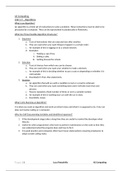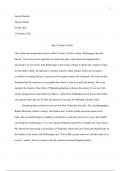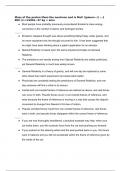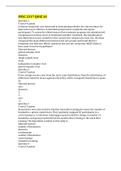Problem Set 5 (6% grade – 0.5 points/question)
This exercise is designed to explore differences in microbiome diversity and function across
human skin regions using 16S rRNA sequence data. MiSeq amplicon sequence files were
processed in dada2. Dada2 generates amplicon sequence variants (ASVs) and classifies them
using the SILVA taxonomy.
Download the two files for Problem set 5 in Blackboard. Then load all files into the
MicrobiomeAnalyst MDP tool at https://www.microbiomeanalyst.ca. Use the SILVA taxonomy
for Taxonomy labels. PHG_ASV_tax.txt includes ASV abundances and taxonomy.
Paste below a screenshot of the Data Integrity Check
1. Data Filtering: first remove samples with <1000 reads and submit. Then remove singletons.
Filter ASVs based on their mean abundance and their variance as estimated by an Inter-quantile
range of 10%. Paste screenshot of the Data Filtering/Feature Filter. How many ASVs remain in
the data set after data filtering?
2. Normalization: Do not rarefy your data. Use the Total Sum Scaling (TSS). Make sure that
samples with <1000 reads have been removed. Do not transform your data. What is
normalization aiming to address?
3. Describe how TSS normalization works
4. Create a stacked bar plot depicting percentage abundances for the top 10 genera across all
samples organized by body locations and paste it below. Which is the most prevalent genus?
5. Create a Heat tree comparing taxonomic differences in Families to Phyla between microbial
communities from dirty and clean regions. Paste heat tree below. Is Firmicutes more abundant
in clean or dirty region?
6. In the Heat tree above what Phyla show significant differences in abundance according to the
Wilcoxon Rank Sum test for a p-value cutoff of 0.05?
This exercise is designed to explore differences in microbiome diversity and function across
human skin regions using 16S rRNA sequence data. MiSeq amplicon sequence files were
processed in dada2. Dada2 generates amplicon sequence variants (ASVs) and classifies them
using the SILVA taxonomy.
Download the two files for Problem set 5 in Blackboard. Then load all files into the
MicrobiomeAnalyst MDP tool at https://www.microbiomeanalyst.ca. Use the SILVA taxonomy
for Taxonomy labels. PHG_ASV_tax.txt includes ASV abundances and taxonomy.
Paste below a screenshot of the Data Integrity Check
1. Data Filtering: first remove samples with <1000 reads and submit. Then remove singletons.
Filter ASVs based on their mean abundance and their variance as estimated by an Inter-quantile
range of 10%. Paste screenshot of the Data Filtering/Feature Filter. How many ASVs remain in
the data set after data filtering?
2. Normalization: Do not rarefy your data. Use the Total Sum Scaling (TSS). Make sure that
samples with <1000 reads have been removed. Do not transform your data. What is
normalization aiming to address?
3. Describe how TSS normalization works
4. Create a stacked bar plot depicting percentage abundances for the top 10 genera across all
samples organized by body locations and paste it below. Which is the most prevalent genus?
5. Create a Heat tree comparing taxonomic differences in Families to Phyla between microbial
communities from dirty and clean regions. Paste heat tree below. Is Firmicutes more abundant
in clean or dirty region?
6. In the Heat tree above what Phyla show significant differences in abundance according to the
Wilcoxon Rank Sum test for a p-value cutoff of 0.05?










